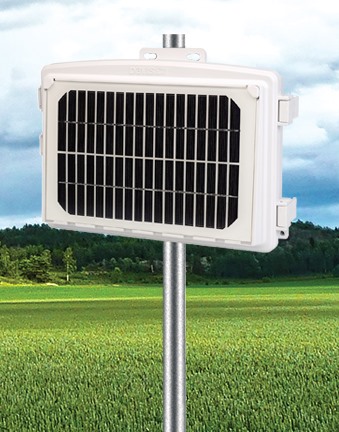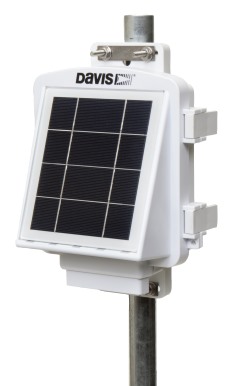Gateway
An EM Gateway is the link between the local site and the Weatherlink cloud platform. The local gateway receives data from all nodes within wireless range and uploads data across the mobile phone network to the central Internet platform at weatherlink.com .

Wireless gateways seem to use the same case and solar power supply as Vantage Connect units and so look superficially identical, though of course with different internals. One gateway can receive data from 20 or more nodes, subject to wireless range limits.
Communication between gateway and nodes is via a ZigBee wireless mesh, working in similar frequency bands to the existing Davis wireless systems (i.e. 900MHz band for N America and 868MHz elsewhere), but the EM protocol is not compatible with the Vue/VP2 protocols and wireless components cannot be intermixed between the two systems.
The ZigBee mesh principle has two important features:
- The same wireless protocol is used to communicate from node to gateway and from node to node;
- In a configuration that uses multiple nodes, an intermediate node can act as a repeater for a more distant node – no need therefore for separate repeaters. And if a distant node has more than one path through intermediate nodes to the gateway then the mesh will automatically fail over to an alternate path if a node should ever go offline;
Node-to-node distance is potentially up to 600m line-of-sight under ideal conditions, but it’s probably better to work with a preferred maximum of 300m in practice.
If an EM installation is specified to include weather sensors then this is currently achieved by using a cabled VP2 ISS wired direct to a gateway – an ISS is the only sensor type to link to a gateway (and ISS units can only be connected to a gateway and not to a node).
Nodes

Each EM node communicates with other nodes and its gateway as described above. Each node is able to accept up to four sensors of various types, each being wired into the node. The extensive range of compatible sensors is described below.
The sensor configuration for each node is uploaded to it via Bluetooth from the EM smartphone app whenever a new node is installed or reconfigured.
The node is one of the innovations in the EM range, being fully self-powered by 3W solar panel and lithium-ion battery pack and using an intermediate form factor.
Sensor connections into the node can be made with either bare conductor connections or using an adapter that accepts RJ11 plus from sensors such as Davis temperature and temperature/humidity sensors.
